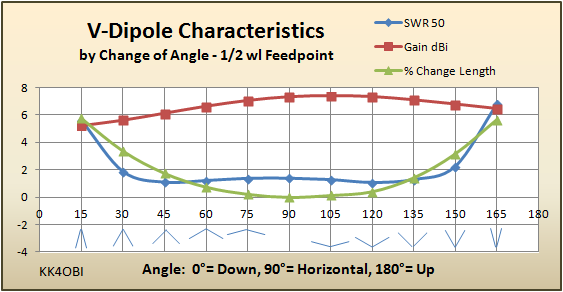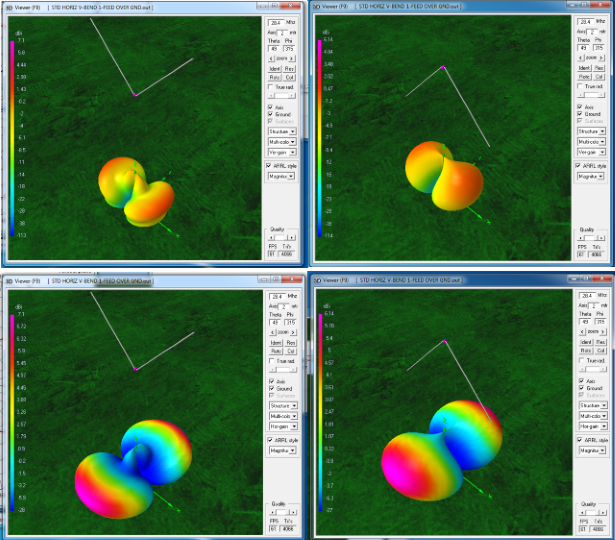Navigation
Menu
Center-fed Bent-Dipoles
Horizontal Lateral
Vertical
- OCF
Slow-Wave
Other Topics
Home
You Bend a Dipole Into a "V"?
The
inverted-V form is common where there is only
one high place, often a pole, to hang a long wire antenna.
Another often seen upright V-form is in the Buddy Pole or the similar
MFJ Big Ear portable dipole. Upright or inverted, either form
reduces the horizontal length to save space.
To answer to the obvious question about "What happens if..", is where antenna modeling comes in. For this study a model was developed to allow the setting of the arms of the "V" to any angle up or down. The optimizer function of the program iteratively tries various lengths of wire to find the lowest SWR and reactance (X-in) when the wire is bent into the specified "V" form. Using the model, this study looks at the changes in antenna characteristics every 15 degrees angle of the arms.*
4NEC2 Antenna Model: Here
The characteristics of a Horizontal V-Dipole are most effected by whether the V-form arms move closer or farther from the ground. In Figure 1 below, note the general pattern of low-to-the left, high-to-the right as the arms move upward away from ground. The blue antenna graphic under each angle number shows the actual angle.
* The degrees of the angle included between each arm is twice the angle number. For example, at the 45° number the included angle is 2 * 45 = 90°... a right angle. Same at the 135° number. 2 * 135 = 270°, where 360 - 270 = 90°. Altenatively, use negative angles. 135 - 180 = -45°. Then, 2 * -45 = 90°.

GAIN
SWR
LENGTH
We now turn to:
From antenna modeling in Figure 1 we see that a V-antenna is a shortened dipole For tuning you need to lengthen it according to bend . It does not become omni-directional. The pattern merely becomes fatter.
An up-bend means more skyward radiation, narrower pattern, good gain. A down-bend means higher takeoff angle, wider pattern, lower gain.
Lets look at two far field radiation patterns of a V-dipole. On the left the included angle between arms is 90 degrees pointing Up and, on the right, 90 degrees pointing Down. Below, every 3D picture is from an identical point in the air (Theta=49, Phi=315) so you can see the relative in change in shape and radiation angles.

V-Up Gain: 7.1 dBi Side Null: -2.9 dBi V-Down Gain: 6.14 Side Null: -1.8 dBi
Lobe angle: 65 degrees Width: 30 degrees Lobe angle: 60 degrees Width: 40 degees
Note: vertical radiation hump when arms up. Note: higher angle of radiation and wider form.
Next, the modeling program also allows us to separate the horizontal and vertical components to visualize gain generated towards the ends of the V-dipoles as well as broadside.

Compare the red portions in all four pictures. Note that with the V pointing upward (left side), the red tends to point more downward . Conversely, with the V pointing downward, the red is more upward. This shows you the relative change in direction of the radiation intensity.
From all this modeling it is clear that the V-Dipole radiation characteristics change little even when the included angle is as narrow as 70 to 80°. It is widely used because it is forgiving of missuse and easy to deploy.
Dick Reid, KK4OBI
To answer to the obvious question about "What happens if..", is where antenna modeling comes in. For this study a model was developed to allow the setting of the arms of the "V" to any angle up or down. The optimizer function of the program iteratively tries various lengths of wire to find the lowest SWR and reactance (X-in) when the wire is bent into the specified "V" form. Using the model, this study looks at the changes in antenna characteristics every 15 degrees angle of the arms.*
4NEC2 Antenna Model: Here
The characteristics of a Horizontal V-Dipole are most effected by whether the V-form arms move closer or farther from the ground. In Figure 1 below, note the general pattern of low-to-the left, high-to-the right as the arms move upward away from ground. The blue antenna graphic under each angle number shows the actual angle.
* The degrees of the angle included between each arm is twice the angle number. For example, at the 45° number the included angle is 2 * 45 = 90°... a right angle. Same at the 135° number. 2 * 135 = 270°, where 360 - 270 = 90°. Altenatively, use negative angles. 135 - 180 = -45°. Then, 2 * -45 = 90°.

Figure 1
A graphic indication of the V-bend is pictured by the blue angles..
A graphic indication of the V-bend is pictured by the blue angles..
GAIN
Following Red Line at the top,
you see that the gains drops away more rapidly as the dipole is bent
toward ground. From the 7.32 dBi gain of the standard horizontal
dipole at the 90° mark, the V-dipole gain drops to around 6 dBi
at the 45° mark and 5 dBi at the 15° mark.
On the other hand, when the dipole is bent upward the gain actually rises slightly in the 105° through 130° area. Even at the extreme of 165° the gain is only slightly affected at 6.5 dBi.
On the other hand, when the dipole is bent upward the gain actually rises slightly in the 105° through 130° area. Even at the extreme of 165° the gain is only slightly affected at 6.5 dBi.
SWR
Following
the Blue Line, you can see that with bends at 45° and 120°,
the SWR changes towards a more desirable 1.1 from the 1.38 SWR of the
standard horizontal dipole. After the 45°/120° bend points you
can see how rapidly the SWR rises. Not good but workable in a
pinch.
LENGTH
When you bend a dipole, the
electrical length changes. Because of this, retuning goes with bending.
Following the Green Line on the graph, the message is: the more you
bend, the more wire you need... up to 4 or 5% longer.
There is a little known configuration that eliminates retuning at any angle, the flat-top V-dipole.
There is a little known configuration that eliminates retuning at any angle, the flat-top V-dipole.
We now turn to:
"What happens to Radiation Patterns when you
bend a dipole into a V-form?"
From antenna modeling in Figure 1 we see that a V-antenna is a shortened dipole For tuning you need to lengthen it according to bend . It does not become omni-directional. The pattern merely becomes fatter.
An up-bend means more skyward radiation, narrower pattern, good gain. A down-bend means higher takeoff angle, wider pattern, lower gain.
Lets look at two far field radiation patterns of a V-dipole. On the left the included angle between arms is 90 degrees pointing Up and, on the right, 90 degrees pointing Down. Below, every 3D picture is from an identical point in the air (Theta=49, Phi=315) so you can see the relative in change in shape and radiation angles.
LEFT COLUMN: Arms
up
at 135°
RIGHT COLUMN: Arms down at 45°
TOP GRAPHS: Total Gain
Vertical-Horizontal Patterns
BOTTOM PICTURES: Total Gain by 3D overhead view
BOTTOM PICTURES: Total Gain by 3D overhead view

V-Up Gain: 7.1 dBi Side Null: -2.9 dBi V-Down Gain: 6.14 Side Null: -1.8 dBi
Lobe angle: 65 degrees Width: 30 degrees Lobe angle: 60 degrees Width: 40 degees
Note: vertical radiation hump when arms up. Note: higher angle of radiation and wider form.
Next, the modeling program also allows us to separate the horizontal and vertical components to visualize gain generated towards the ends of the V-dipoles as well as broadside.
LEFT COLUMN: Arms up
at 135°
RIGHT COLUMN: Arms down at 45°
TOP PICTURES: 3D Vertical
Gain towards ends
BOTTOM PICTURES: 3D Horizontal Gain broadside
BOTTOM PICTURES: 3D Horizontal Gain broadside

Compare the red portions in all four pictures. Note that with the V pointing upward (left side), the red tends to point more downward . Conversely, with the V pointing downward, the red is more upward. This shows you the relative change in direction of the radiation intensity.
From all this modeling it is clear that the V-Dipole radiation characteristics change little even when the included angle is as narrow as 70 to 80°. It is widely used because it is forgiving of missuse and easy to deploy.
Dick Reid, KK4OBI

